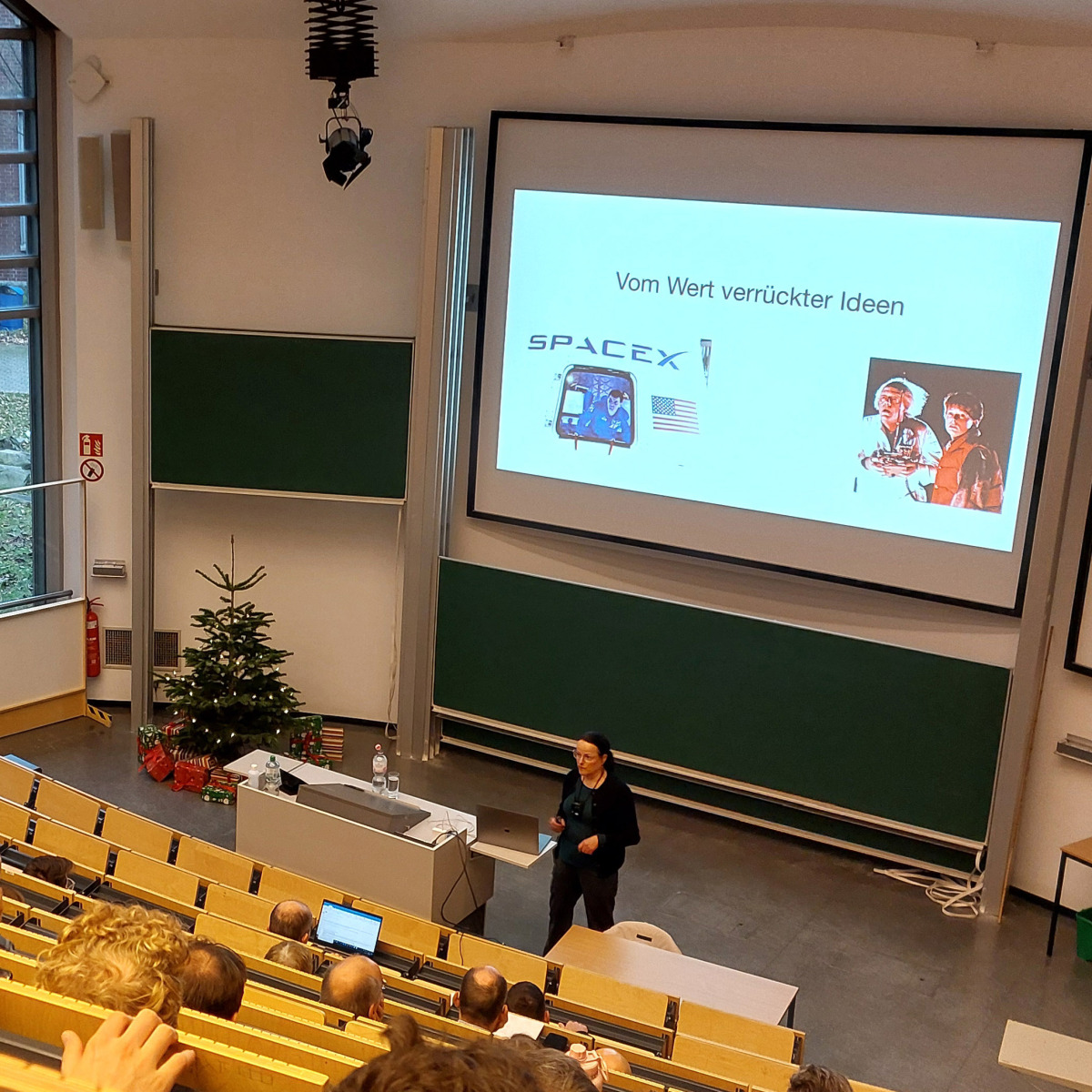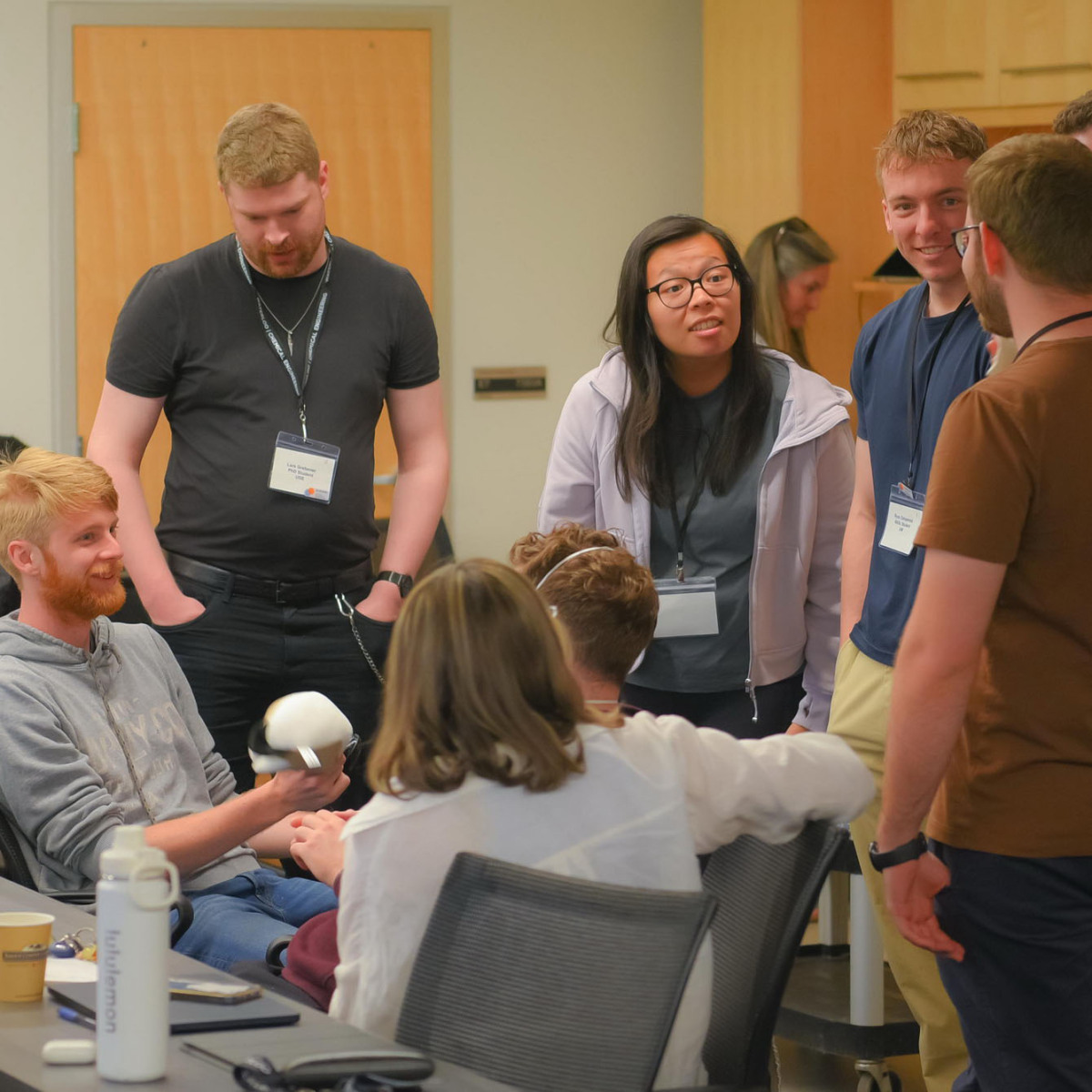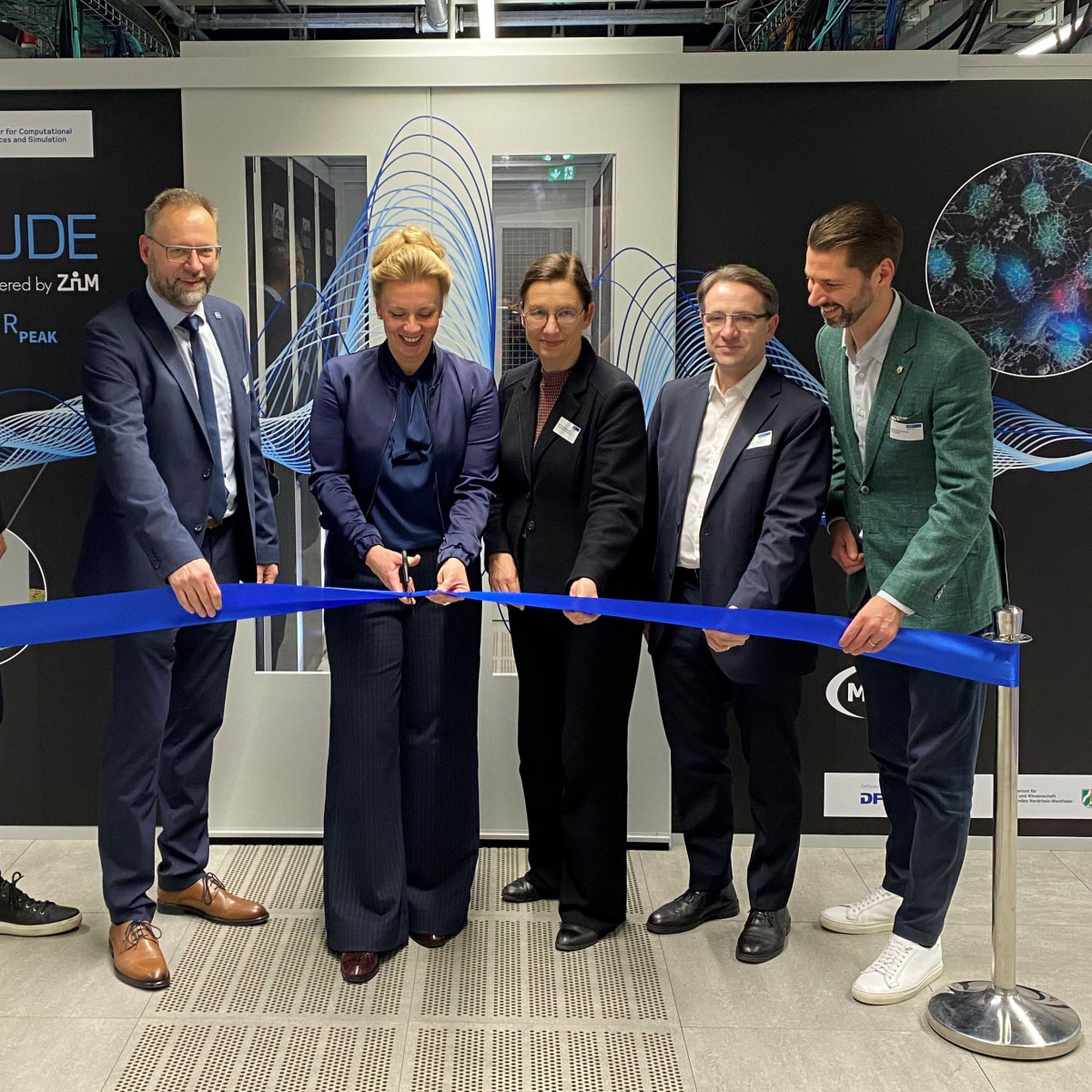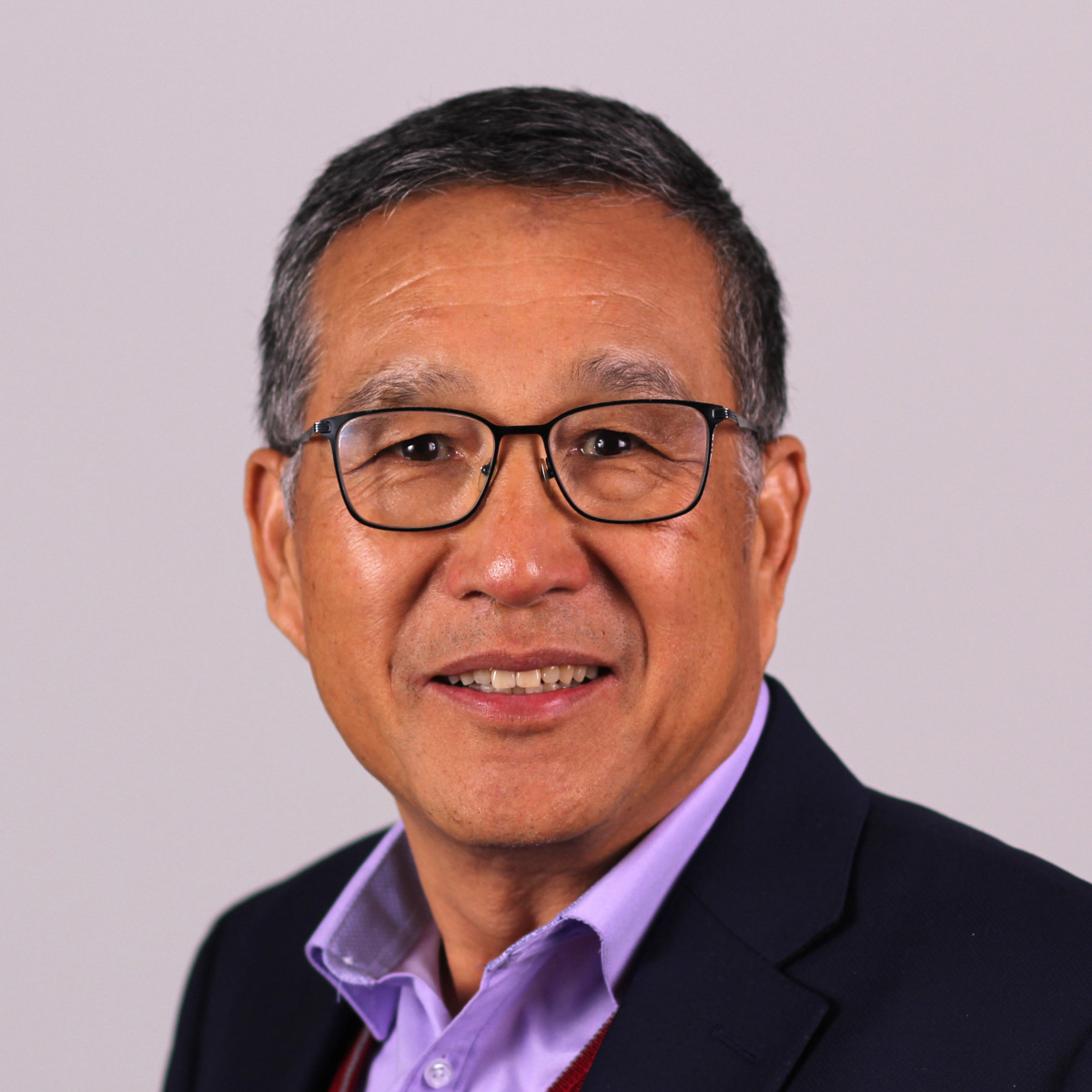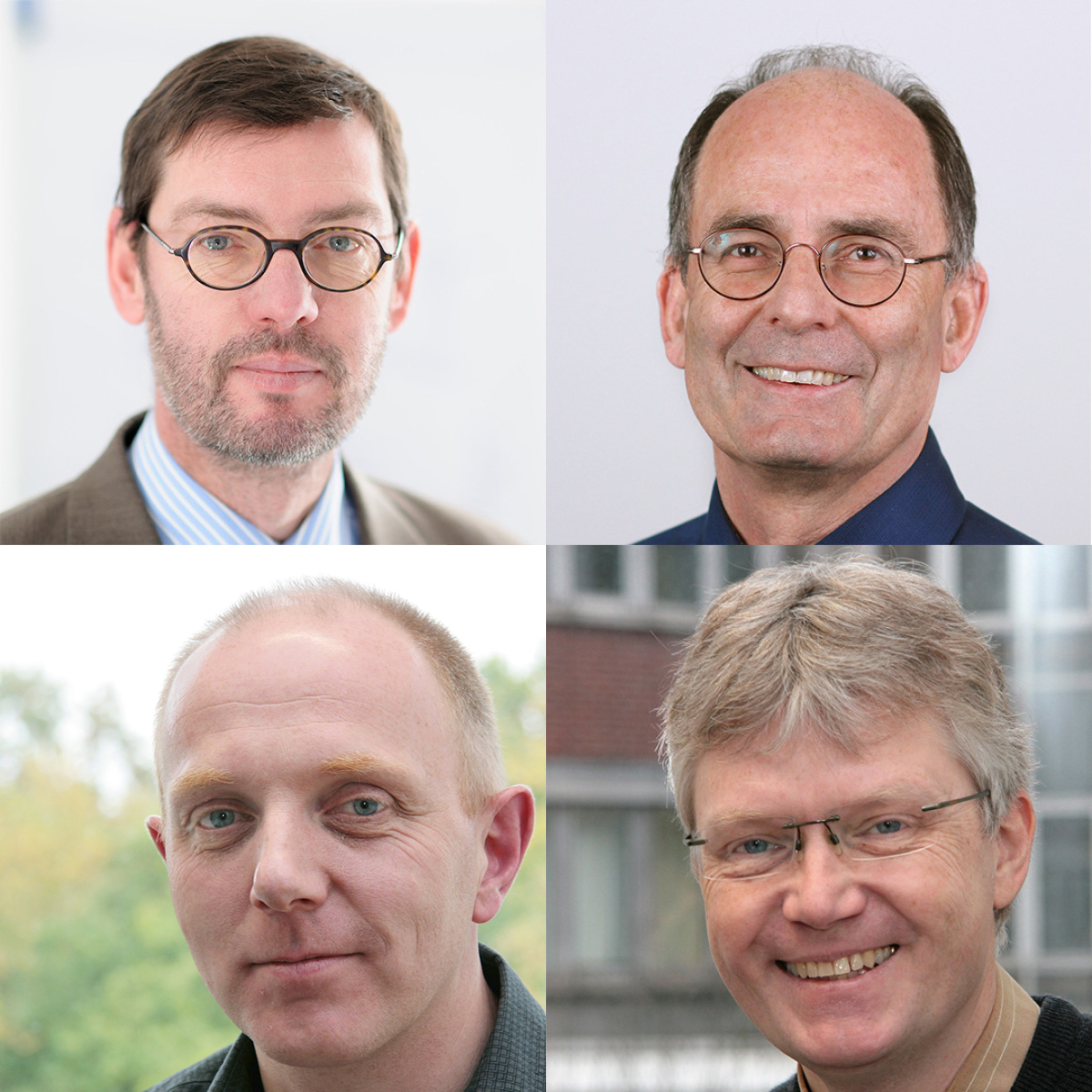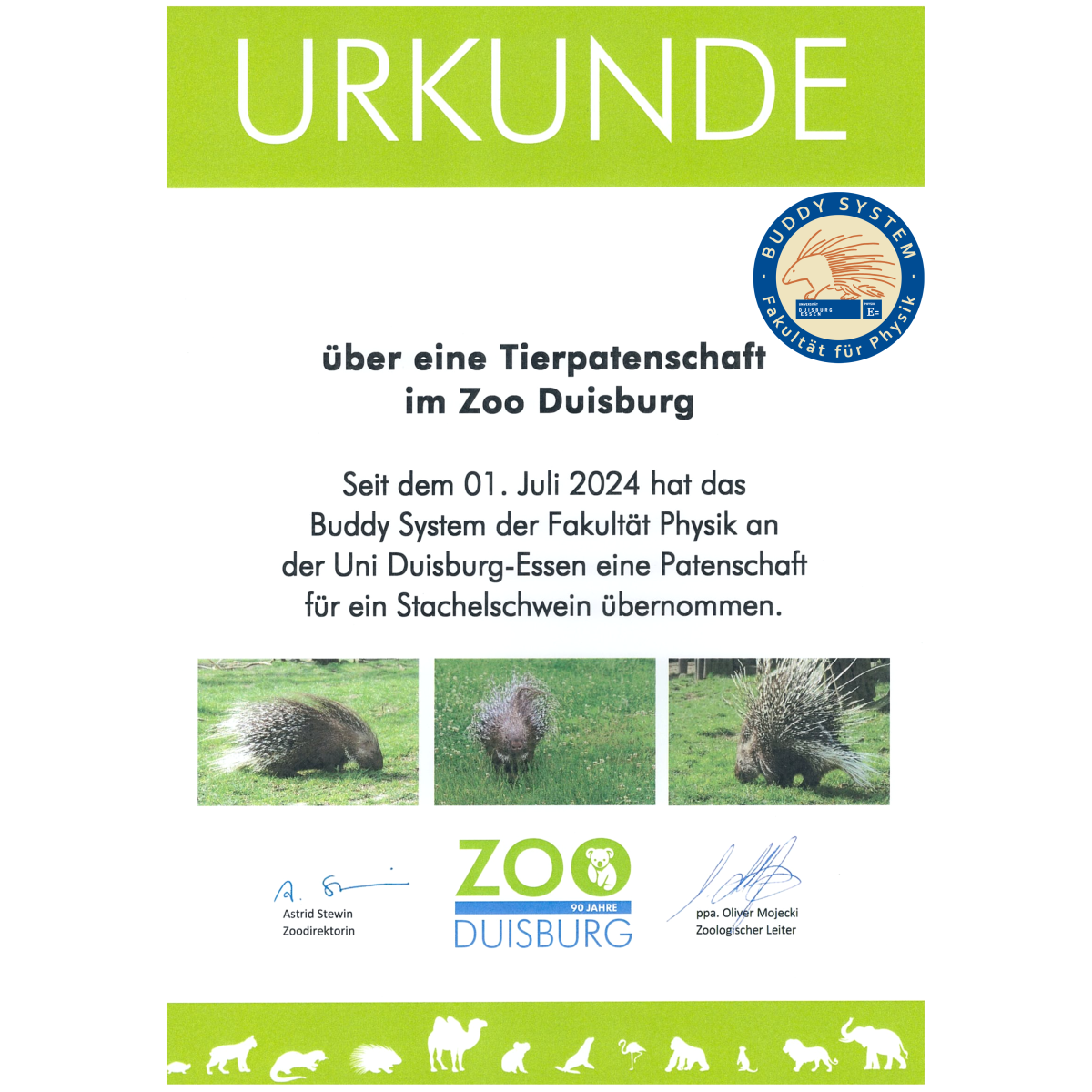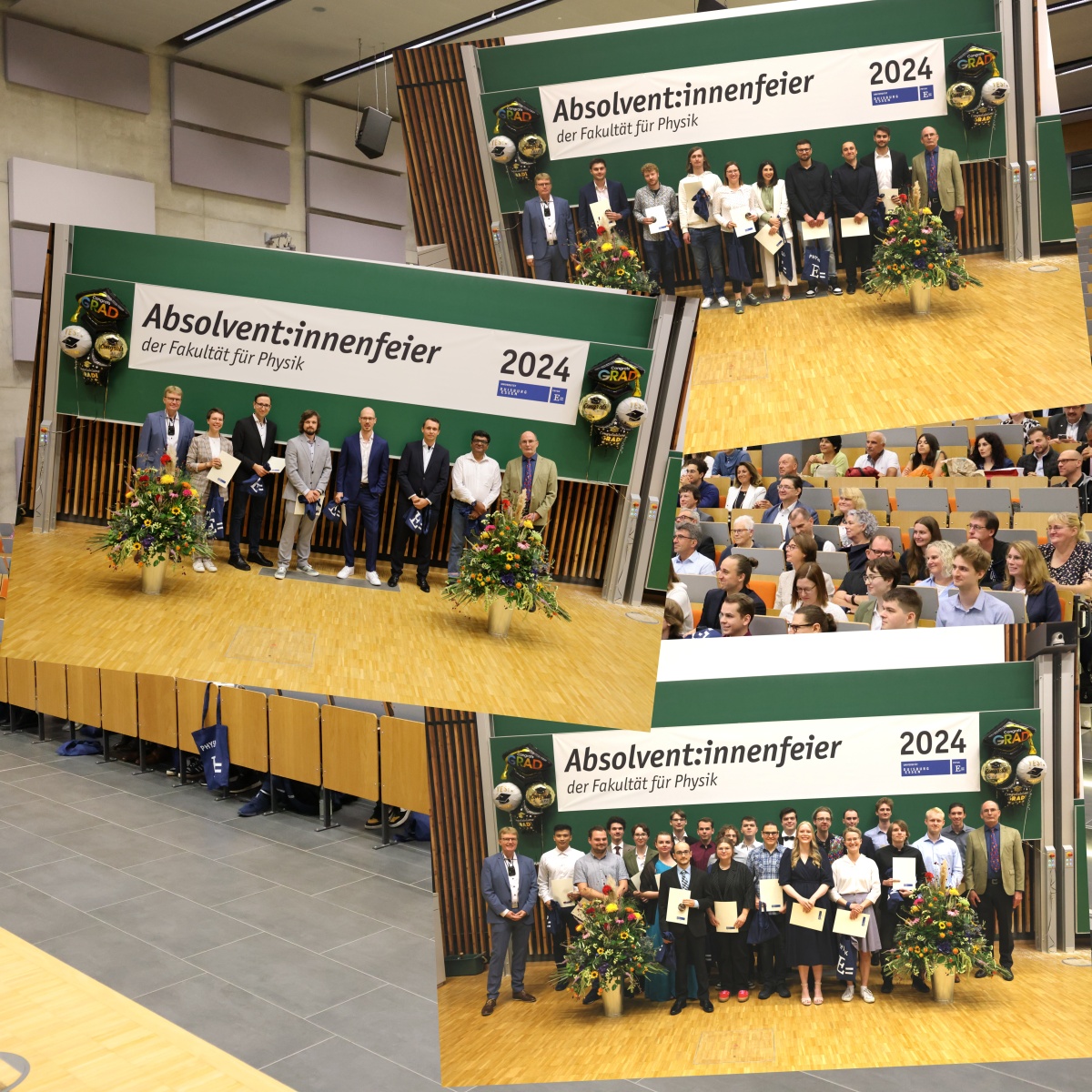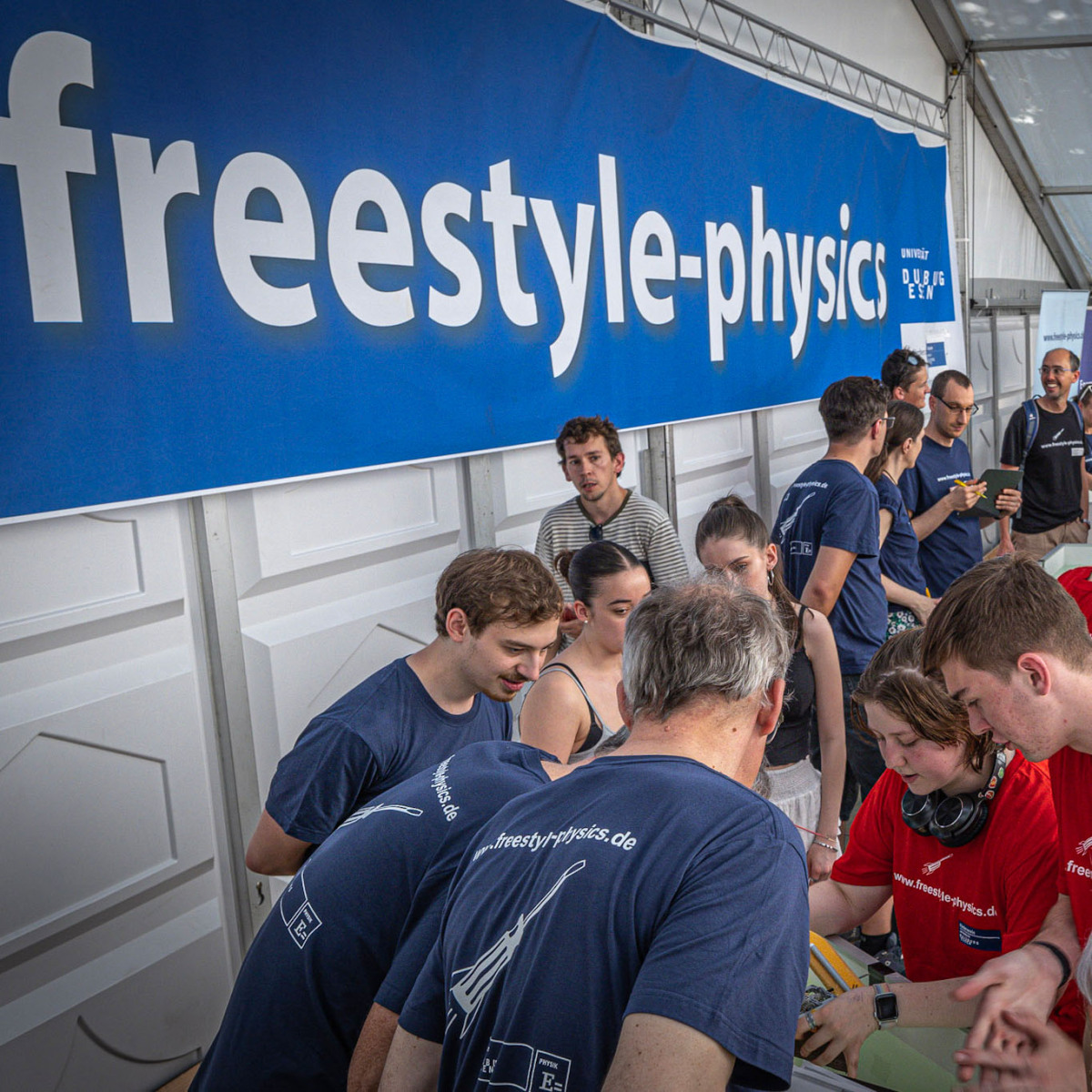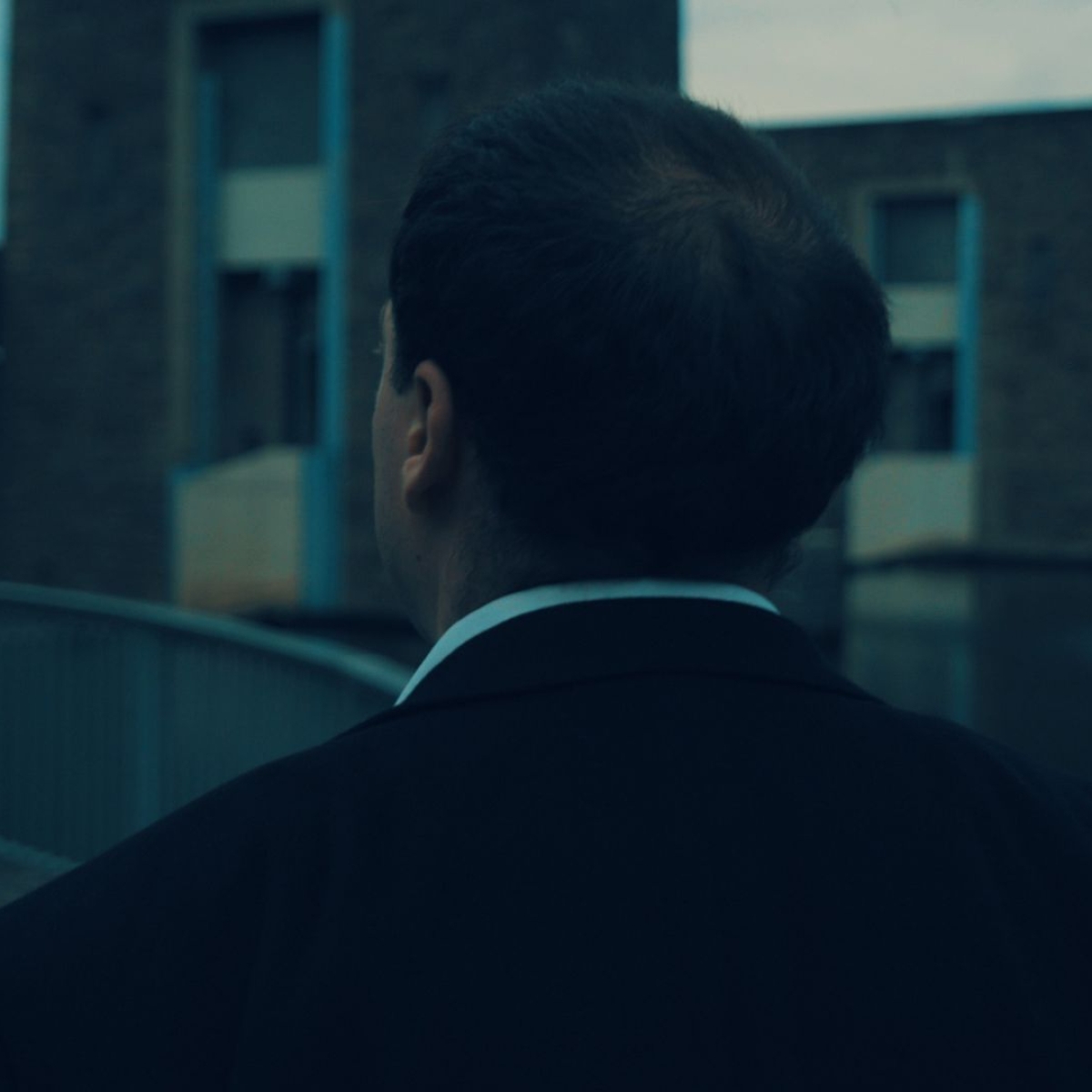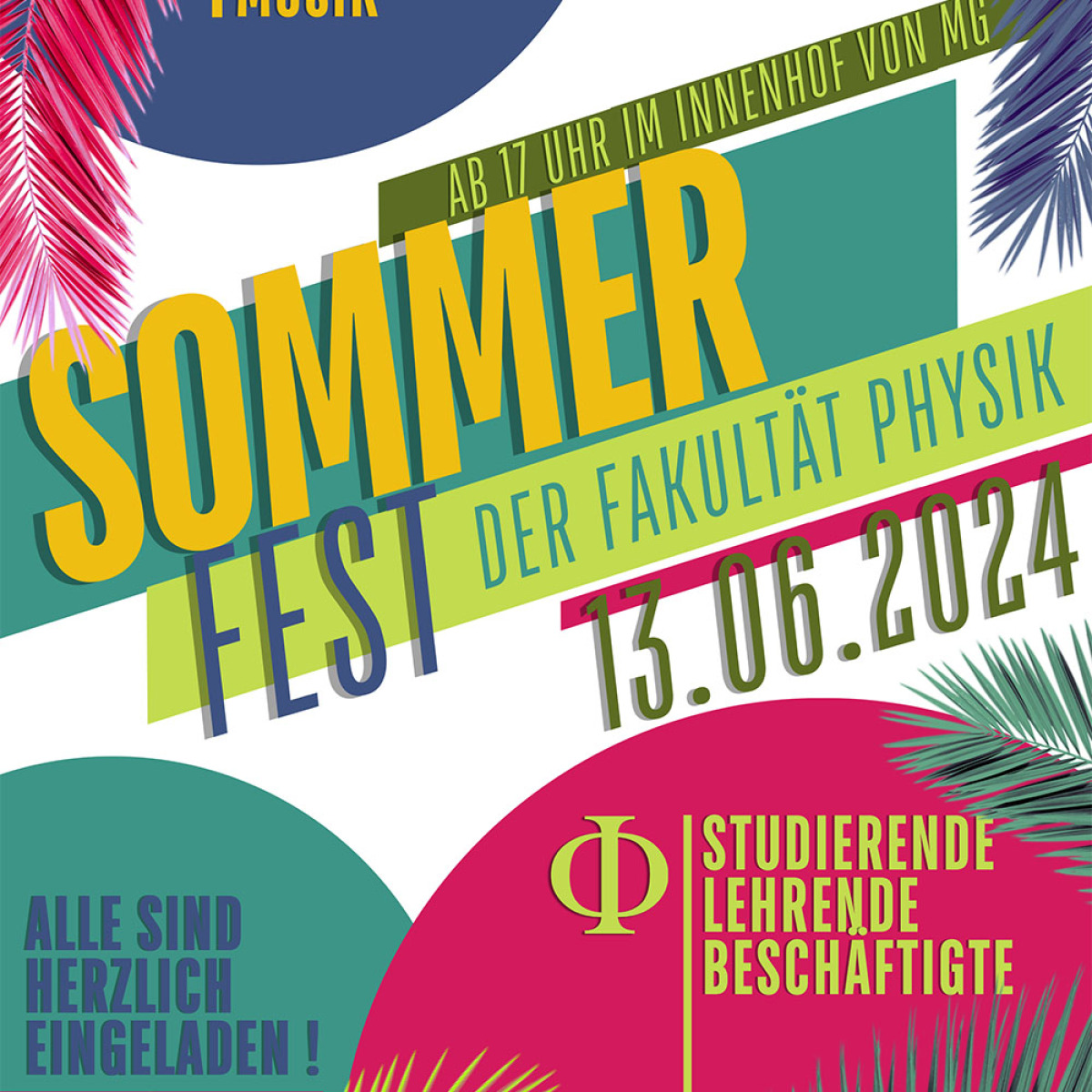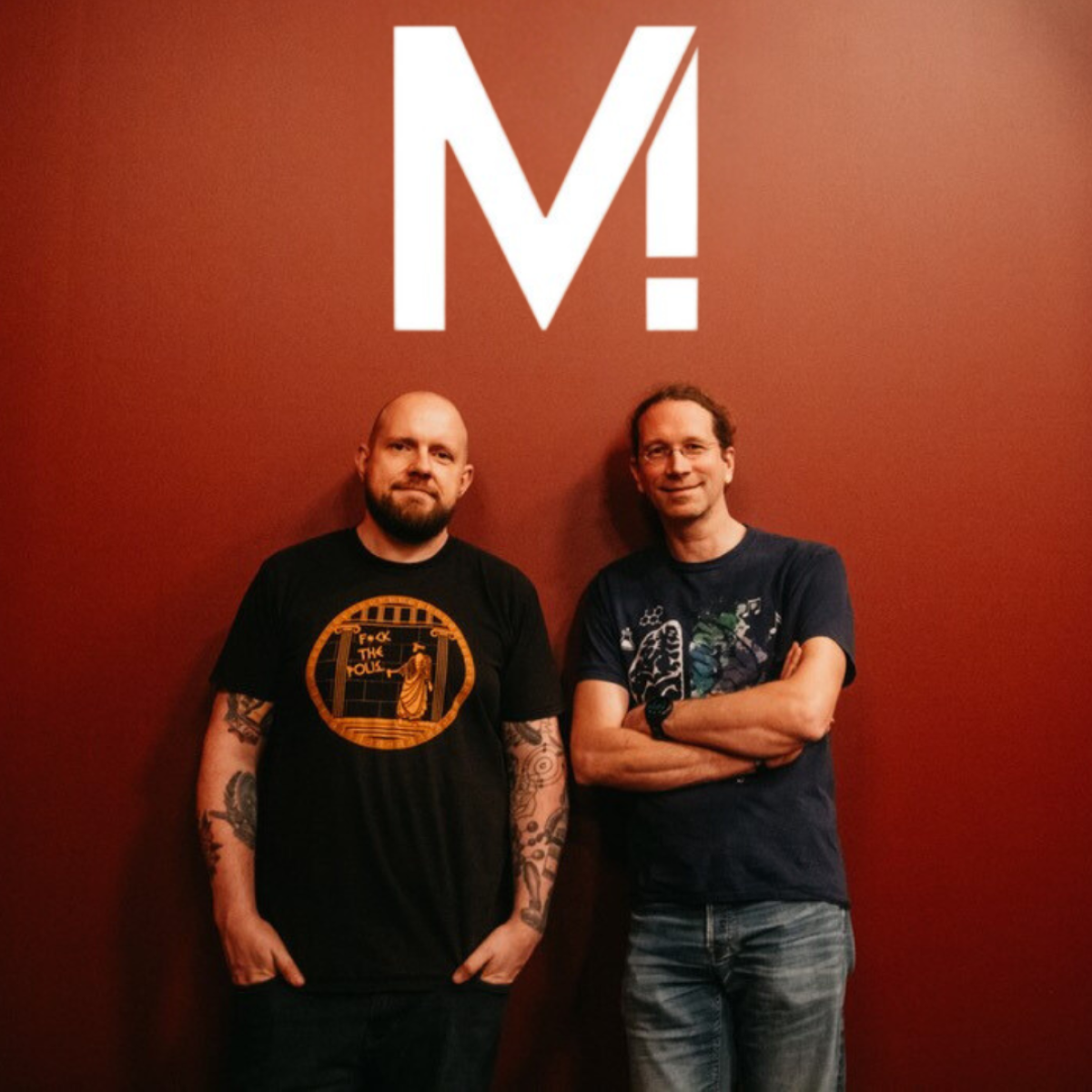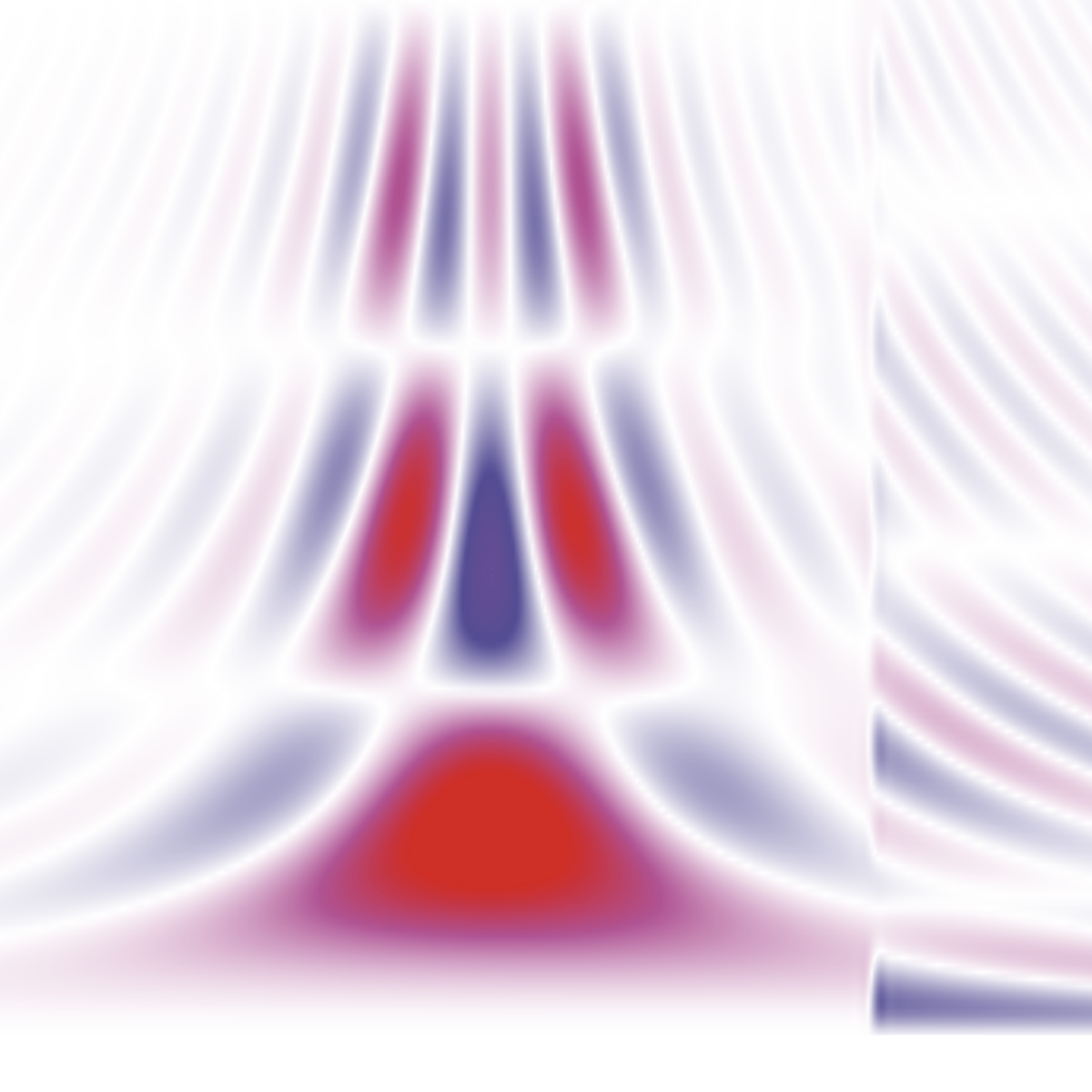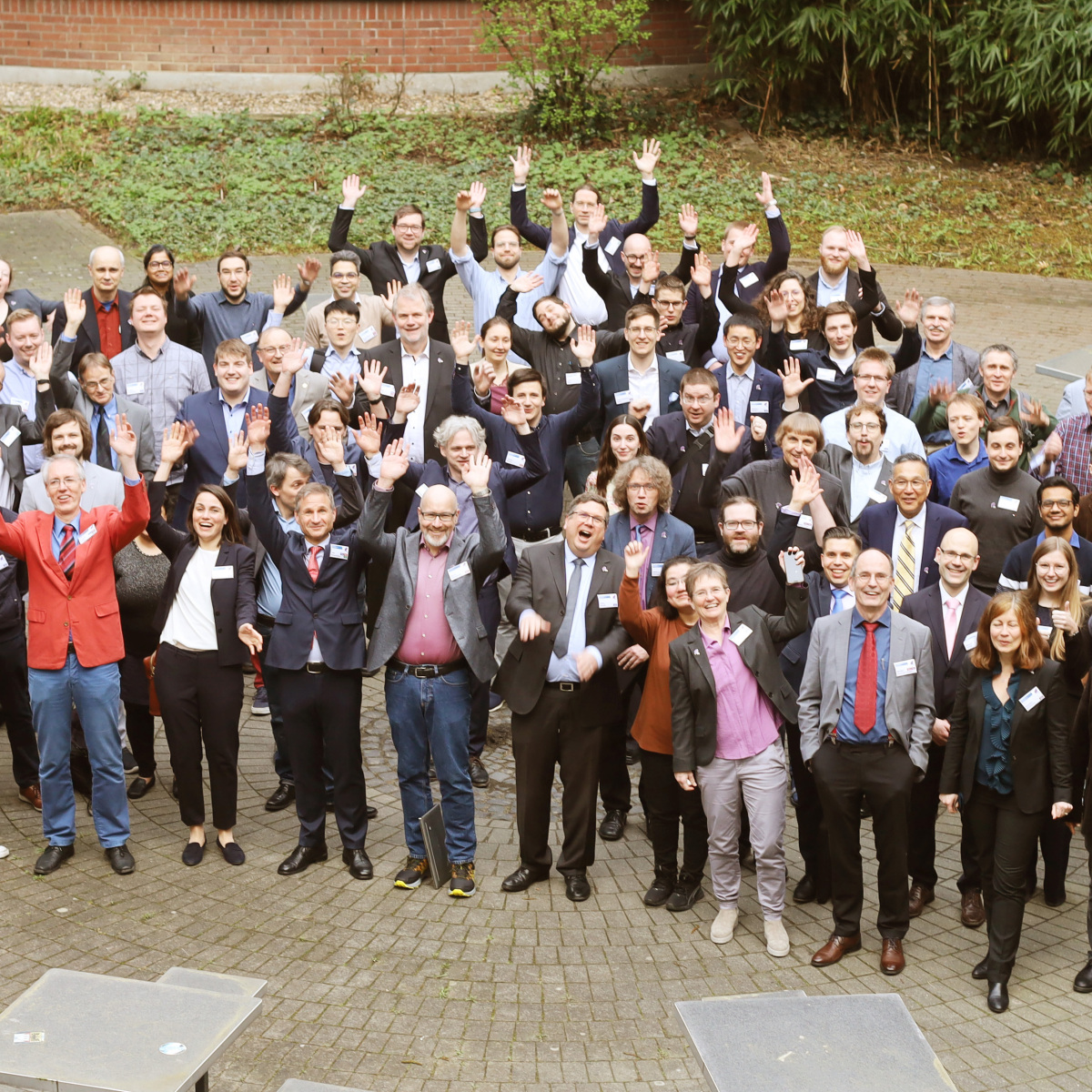News archive 2024
12.12.2024Faculty Day of the Faculty of Physics
All employees of the Faculty - i.e. all professors, technical and administrative staff, doctoral students and postdocs - were invited on 11 December 2024 to look back together on the past successful year 2024 and celebrate it in style. After the review and outlook by Dean Prof Dr Michael Schreckenberg, Ig Physics Nobel Prize winner Prof Dr Sabine Begall gave us an entertaining, surprising and, last but not least, amusing insight into her field of research, ‘The value of crazy ideas’. Greyhounds and cows that orientate themselves by the magnetic field played an important role. Mulled wine, coffee and cake were the ingredients for many interesting conversations at the end of the event.
09.12.2024Graduate programme 2D MATURE enters the next phase - PhD students wanted!
The international DFG-funded graduate programme 2D MATURE is entering the next phase. Together with the partners in Waterloo, the doctoral students are developing and researching scalable manufacturing processes for 2D materials and the corresponding devices. The first generation of doctoral students has now returned from Canada, has already achieved considerable success there and is now entering the home straight. We are therefore looking for new doctoral students who would like to take up the baton. All information on the attractive positions to be filled from summer 2025 can be found here.
03.12.2024New supercomputer strengthens research in the Faculty of Physics - high-performance computer amplitUDE inaugurated
A new boost for research: Ina Brandes, Minister for Culture and Science of the State of North Rhine-Westphalia, and Rector Prof. Dr Barbara Albert inaugurated the new amplitUDE supercomputer at the University of Duisburg-Essen today, Monday 2 December. With its enormous computing power and energy-efficient technology, it opens up new perspectives for big data applications in research.
amplitUDE, the new high-performance computer, officially goes into operation today at the Duisburg-Wedau data centre of the University of Duisburg-Essen (UDE). ‘The future of AI for people is being researched and shaped in North Rhine-Westphalia. The key to ‘AI made in NRW’ is computing power. The ‘amplitUDE’ super-computer is one of the most energy-efficient computers in the world and opens up new opportunities for our scientists, for example, to develop customised diagnostic and therapeutic options for each patient and to work on smart solutions for better and cleaner mobility,’ explained Minister Ina Brandes at the inauguration.
With 29,008 computing cores, 188 terabytes of main memory and specialised graphics cards (GPUs), amplitUDE is available to UDE researchers for simulations in the natural and engineering sciences, the analysis of medical data or the development of large language models for artificial intelligence. Its architecture is so flexible that it can perform complex calculations in parallel as well as store and analyse huge amounts of data.
The high-performance computer also sets standards in terms of energy efficiency: in test runs shortly after its construction in 2023, it was ranked 8th in the global ‘Green 500’ list. Among other things, this is made possible by a sophisticated cooling system: direct hot water cooling will efficiently feed the waste heat into the surrounding district heating network in future. In this way, amplitUDE combines cutting-edge technology with sustainability - a goal that UDE has also anchored in its digitalisation strategy.
Since 2010, UDE has been offering its scientists state-of-the-art resources for high-performance computing. The new amplitUDE system complements the two previous high-performance computers with six times the computing power of its direct predecessor, magnitUDE.
The system was acquired through a large-scale equipment application for more than 7 million euros from the German Research Foundation and the state of North Rhine-Westphalia. ‘The Faculty of Computer Science is now significantly increasing its capacity for calculating large AI models by acquiring a GPU cluster worth a good 1.3 million euros. With this substantial expansion, amplitUDE can make it onto the TOP500, a list of the 500 fastest supercomputers in the world, for the second time,’ says Prof. Dr Pedro José Marrón, Vice-Rector for Transfer, Innovation and Digitalisation and Chief Information Officer at UDE.
High-performance computing at UDE is accessible at a low threshold; it is a system by researchers for researchers. Scientists from less data-intensive disciplines such as the humanities or social sciences also have access to advice and support services from the Centre for Information and Media Services and High Performance Computing.
The new mainframe computer is integrated into the UDE's Centre for Computational Sciences and Simulation. This integration also strengthens co-operation within the HPC.NRW competence network, to which amplitUDE makes an important contribution.
Report in the local news programme from Duisburg (from 7:35 min, in German)
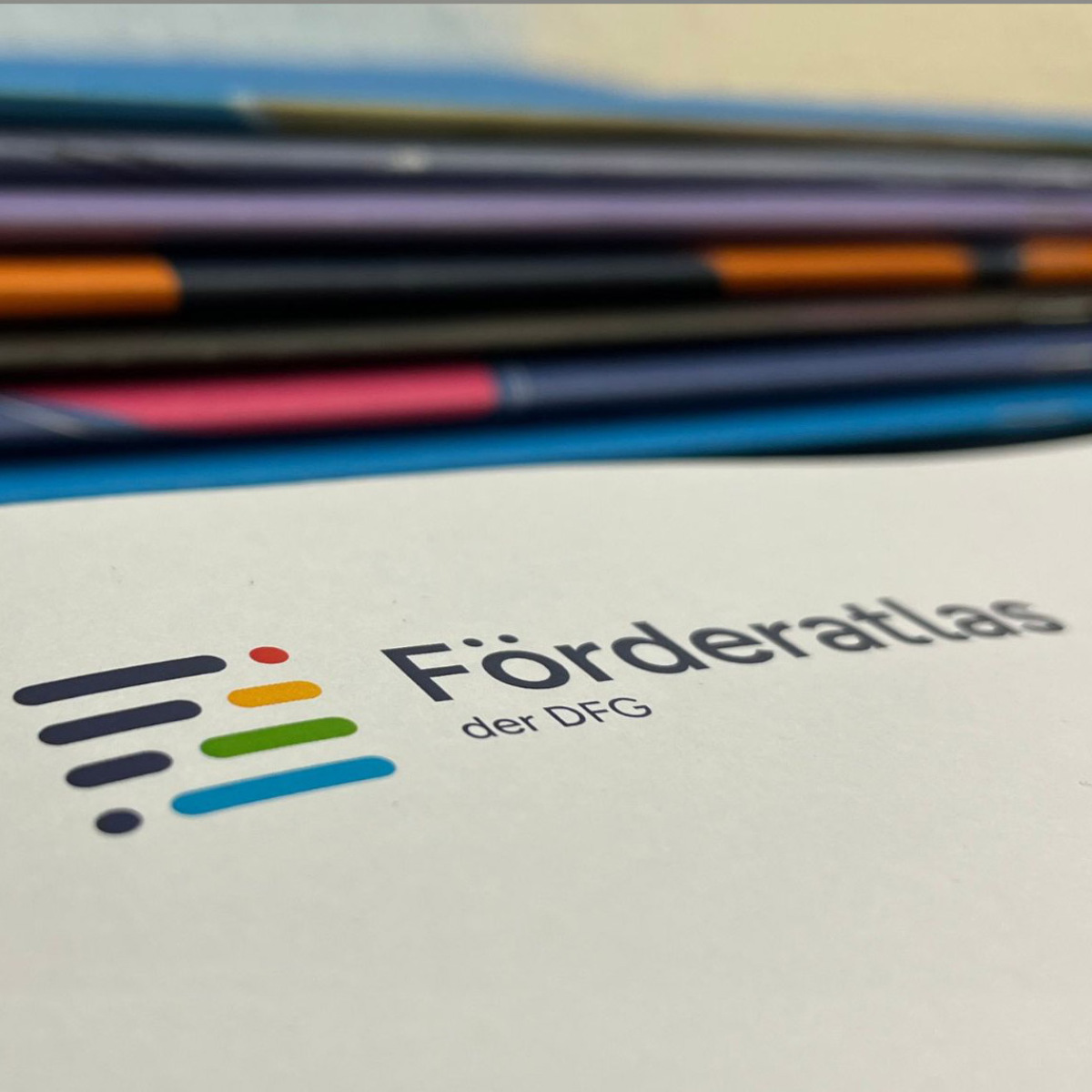
02.12.2024Success in acquiring third-party funding
The upward trend continues: In the German Research Foundation's (DFG) Funding Atlas 2024, Physics at UDE is ranked 18th among German universities, moving up 3 places compared to the 2021 Funding Atlas. Among the universities in North Rhine-Westphalia, our faculty is in 5th place. The ranking is based on DFG awards for 2020 to 2022, with researchers at our faculty acquiring a total of 15.4 million euros from the DFG during this period.
18.11.2024Night of Physics – Dancing brushes and electron hunting
Build a solar system, test the authenticity of a brilliant, stop time with light or go on an electron hunt - this and much more is on offer at the Night of Physics at the UDE on Friday, 22 November. The popular hands-on programme for children and adults is free of charge and can be attended without registration from 5 pm to 11 pm (Keksdosen, Lotharstr. 1, Duisburg Campus).
This year, the scientists will take you to the frontiers of the universe and answer questions such as: What is life like on Mars? How do planets form? In their laboratories, they will show how a pane of glass becomes a solar cell and what happens in the nanoworld. And there are exciting lectures: What physics is behind clouds, wind and rain? Why can you see through a window pane - but not through the frame? And: Women save the world - about (in)famous female scientists.
If you want, you can get active yourself: for example, you can make crystals grow, test things for authenticity with a special spectrometer (such as a wedding ring), build a solar system or experiment with magnetic materials. Children can also pick up a screwdriver, wire and cable to make a brush racer.
Every hour, employees give a guided tour of the faculty's clean room, where research is carried out on semiconductor chips and extremely thin materials. The tour of the photoluminescence laboratory is enlightening. Here, the tiniest nanoparticles and two-dimensional materials are researched using lasers. In other rooms there are interactive exhibitions and students show why studying physics at the UDE is definitely worthwhile.
On 22 November, fun is guaranteed - and the realisation that physics is modern, versatile and true to life!
Please note: The event is also accessible with a wheelchair, walking frame or pushchair.
11.11.2024Closed meeting of the faculty
Where are we going and what do we want to do there?
The professors of our Faculty of Physics met on November 7 and 8, 2024 for a two-day closed meeting in Heiligenhaus to discuss in a creative and constructive atmosphere where the focus should be in teaching and research and what the structure of the faculty should look like in the future.
07.11.2024Why do we need better magnets?
Magnetic materials play an important role for energy-efficient energy conversions in the energy mix of future technologies, be it in future cooling and air-conditioning concepts, be it in electrical machines (generators in wind and hydroelectric power plants, electric motors in robots or motor vehicles) or in information processing. A series of presentations and publications from the SBF/TRR270 ‘HoMMAge’ research network will provide insights into the research steps that are necessary NOW for the sustainable and energy-efficient use of magnet technologies, which are also easy to understand for non-experts. In addition to Prof. Dr. Michaael Farle as co-spokesperson, several other members of our faculty are part of the scientific team of this programme. Further information can be found under the following links.
Further information:

04.11.2024Energy Science Day 2024
On Wednesday, 6 November 2024, the Faculty of Physics will host this year's Energy Science Day. The event is aimed at the students of the degree programme - including the new first-semester students and also interested physics students who would like to find out about their fellow students' experiences abroad.
17:00 Welcome by Martin Mittendorff
17:10 Presentations by alumni Julius Kruip and Frederik Steinkamp
18:00 Reports from the year abroad, e.g. from Sweden, Greece, Austria, ...
Parallel to the student presentations, pizza will be served.
04.10.2024First joint Research Alliance Ruhr appointment – From Stanford to the Ruhr region
Editor: Dr. Alexandra Nießen
Top researcher Prof. Dr. Xijie Wang has taken up his professorship for ultrafast electron diffraction at two universities. It is a first for the University Alliance Ruhr and its newly founded Research Alliance. In future, the renowned physicist will be researching at both the University of Duisburg-Essen and TU Dortmund University. Prior to his move, Wang was a distinguished scientist at the SLAC National Accelerator Laboratory at the elite American university Stanford for ten years.
Professor Dr. Xijie Wang is known worldwide for his unique research experiments: He investigates how extremely rapid changes in materials can be made visible. Now he will establish the method of Mega-Electron-Volt Ultrafast Electron Diffraction (MeV-UED) at the two University alliance Ruhr universities, their physics departments, and the Research Center Chemical Sciences and Sustainability of the Research Alliance Ruhr. The University of Duisburg-Essen has appointed him for this purpose, and he has been seconded to TU Dortmund University on a 50 percent basis.
Wang is planning to build up a MeV-UED facility a unique experimental setup dedicated to both liquid phase chemistry and solid quantum materials. The DELTA Center for Synchrotron Radiation in Dortmund will be upgraded to accommodate the new experimental setup. This building not only guarantees the best conditions for the research of the highly respected physicist, but it will also become an important location for other scientists of the Research Center Chemical Sciences and Sustainability, plus it will strengthen the cutting-edge research in the RESOLV Cluster of Excellence of Ruhr University Bochum, the third partner in the University Alliance Ruhr.
Ultrafast electron diffraction enables the observation of natural processes with extremely high temporal resolution in the femtosecond range. The electrons used by Professor Wang almost reach the speed of light. “In the experiment, we shoot a very energetic beam of electrons at a material. When they hit atoms, the electrons 'bounce' off and are scattered in different directions. This scattering (or 'diffraction') creates a pattern that we see on a special screen. On this basis, we can make a movie that shows how the atoms are arranged and change in the material,” explains Professor Xijie Wang.
Wang developed MeV-UED at the turn of the millennium and has done widely recognized pioneering work in the application of this fastidious method. In 2019, he set up the world's first user facility for MeV-UED at SLAC, an “electron camera” which is now open to a broad scientific community. The potential is huge: “We can for example use ultrafast electron diffraction to find out how water and other substances behave during chemical and biological reactions, ” explains Wang. “This is a useful tool also in the development of more efficient solar cells, new medicines or technologies such as batteries.”
Wang's path led him to the USA after completing his physics degree at Shaanxi Normal University in China in 1982. His first stop there was the University of California Los Angeles, where he received his doctorate in 1992. He conducted research at Brookhaven National Laboratory for over 20 years, and thenmoved to the Stanford Linear Accelerator Center. Among other things, he was significantly involved in research into laser accelerators, high-brilliance electron beams and free electron X-ray lasers. In 2021, he received the prestigious Nuclear and Plasma Science Society’s Particle Accelerator Science and Technology Award from the Institute of Electrical and Electronics Engineers (IEEE), for outstanding contributions to the development of particle accelerator science.He is also the author of numerous renowned publications that have attracted worldwide attention.
04.10.2024Dean's Board re-elected for a further 4 years
At the 136th meeting of the Faculty Council on October 2nd, 2024, the Dean's Office of the Faculty of Physics was re-elected for another 4 years.
Dean (top left):
Prof. Dr. Michael Schreckenberg
Associate Dean (top right):
Prof. Dr. Michael Horn-von Hoegen
Associate Dean (bottom left):
Prof. Dr. Gerhard Wurm
Dean of Studies (bottom right):
Prof. Dr. Hermann Nienhaus
The members of the Dean's Board would like to thank you for the trust you have placed in them.
27.09.2024Field trip into the cockpit of an A320
Once again it has been shown that practice can be an ideal complement to the theory learned in a lecture. A group of students went into the simulator of an A320 and experienced what it feels like to be in the air. From the movement of the aircraft around the three axes, to the relationship between lift and speed and the angle of attack, to a stall, a lot was tried out and a whole new approach to the world of flying was created. Apart from a few hard landings, there were no crashes. Every situation was mastered safely.
The excursion was a supplementary event to Dr. Florian Mazur's “Physics of Aviation” lecture. There are also plans to offer similar excursions in the coming years.
More photos of the excursion can be found on the Instagram channel of the Faculty of Physics.
05.09.2024Chamber concert on energy
Chamber concert plus lecture on the subject of energy
No concert without energy! But there will certainly be no shortage of energy at the first chamber concert in the Philharmonie Mercatorhalle on 15.09.2024! Prof. Dr. Martin Mittendorff from our Faculty of Physics is very much looking forward to his encounter with the gifted cellist Tanja Tetzlaff. The theme of the concert is “Energy” - who better to give a half-hour introduction to this topic than the chairman of the examination board of our Energy Science course?
It's not exactly his first lecture - but the concert introduction together with Tanja Tetzlaff will definitely be a premiere for him! At the concert, Florian Donderer will play the violin, Tanja Tetzlaff the cello and Kiveli Dörken the piano. Afterwards, the sounds of jazz pianist Stefan Casalino will provide a relaxed end to the evening.
In cooperation with the sustainability initiative 'Orchestra of Change', there will be a comprehensive supporting program before and after the concert:
5.30 p.m. Exhibition in the foyer of the Mercatorhalle with stands on the subject of energy, culture and climate protection
6.00 p.m. Lecture on the subject of 'Energy' by Prof. Dr. Mittendorff
6.30 p.m. Concert introduction with Tanja Tetzlaff and Prof. Dr. Mittendorff
7.00 p.m. Start of the concert
09.07.2024Alumni network of the Faculty of Physics – Alumni Reunion 2024
Dear alumni,
The Faculty of Physics at the University of Duisburg-Essen cordially invites you to this year's alumni reunion on 26 October 2024 from 11:00 to 13:00 in the Gerhard Mercator House! Take this great opportunity to meet up with old friends, talk about the time after your studies and find out about news from the faculty.
Make new contacts in a relaxed atmosphere with drinks and a small buffet.
After the meeting, we cordially invite you to explore the faculty's premises.
Several research groups will open their laboratories to give you an insight into current research.
We look forward to welcoming you and to looking back with you on our years together.
Please register for this year's alumni meeting by 30.09.2024 via the following homepage:
Invitation and registration for the alumni reunion of the Faculty of Physics
Please feel free to share this invitation with former fellow students, the more graduates know about it, the better!
09.07.20245 years of sponsorship for "Buddy"
The Buddy System is entering its 5th season in the coming winter semester and is thus celebrating a small anniversary. The sponsorship with porcupine "Buddy" at Duisburg Zoo has been in place for just as long. We look forward to continuing our sponsorship in this anniversary season and continuing this special sponsorship. Here's to many more successful years together!
08.07.2024Graduation ceremony 2024
On July 5th 2024, the Faculty of Physics honored the achievements of Bachelor's theses, Master's theses and doctorates in the Audimax.
Associate Dean Prof. Dr. Michael Horn-von Hoegen welcomed the graduates with an entertaining speech. Dean of Studies Prof. Dr. Hermann Nienhaus then introduced the graduates and, together with the Associate Dean, presented them with a certificate and gifts. They were honored for their work "with distinction" and for their involvement in faculty committees.
The presentation of the student representatives' teaching award to Prof. Dr. Martin Mittendorff and Dr. Florian Mazur and the recognition of four particularly original photos of the graduates brought the official part of the ceremony to a pleasant conclusion, before a reception was held in the foyer to celebrate appropriately. Even the not-so-successful outcome of the European Championship quarter-final between Germany and Spain did not dampen the mood.
All participants enjoyed the evening and it was a successful event. Once again, we would like to take this opportunity to congratulate all the graduates!
A photo album of the graduation ceremony can be found on the event's homepage.
01.07.2024freestyle physics "Goal! The free-kick machine scores!"
by Birte Vierjahn
While the footballers in Groups C and D battle it out for a place in the last sixteen of the European Championships, one goal after another will be scored on the Duisburg campus of the University of Duisburg-Essen - at least that's the plan of the 36 groups trying to score as many goals as possible within two minutes with their free-kick machine. As has been the case every summer for the past 23 years, the freestyle physics finale from 24 to 28 June will once again feature impressive constructions and enthusiastic children for camera and microphone with around 1,500 students.
"We're waiting in the wings and are really looking forward to seeing the kids with their fantastic constructions," says organiser Dr Andreas Reichert from the Faculty of Physics. "Over 80 freestyle physics fans are helping to organise the competition - from students in their first semesters to professors. In addition to great prizes, there will of course be a colourful bouquet of laboratory tours for the children and young people, lots of experiments to do yourself and of course the spectacular physics show."
14.06.2024Film premiere of "The Washer" - UDE goes Hollywood
by Janina Balzer
On June 15th, the film "The Washer", which was shot in Duisburg, will celebrate its premiere at the filmforum. Faces from the University of Duisburg-Essen can also be seen on the screen: three students and a research assistant from the Faculty of Physics. The theme of the independent film, which won the Award of Excellence, is "Time Travel".
In the science fiction and mystery film by Nils Witt, a young lawyer stumbles across time phenomena while doing the laundry that raise all kinds of questions: What actually is time? How do we perceive time? Is time travel even possible? And what actually happens in a black hole? Members of the University of Duisburg-Essen (UDE), such as Dr. Nikodem Szpak, research associate in Theoretical Physics, have answers to these questions. As Professor Stein, he not only answers questions about time in the film, but was also involved in the development of the interview and script.
"Even though time travel is very difficult in practice, it is theoretically possible," explains Szpak, referring to the time phenomena that appear in the film. In addition to the UDE physicist, students Eric Kleinherbers, Magdulin Dwedari and Mathias Kamp can also be seen. If you look closely, you might also recognize one or two UDE lecture halls or catch a glimpse of the university's telescope dome on the roof of the cookie jars in Duisburg.
The film, which was funded by the Cultural Advisory Council of the City of Duisburg, was shot in Duisburg from 2019 to 2021 and was then part of several film festivals in 2024, including the Slamdance Film Festival, The IndieFEST Film Awards and the Berlin Independent Film Festival. "The Washer" is the winner of the Award of Excellence - Film Feature - The IndieFEST Film Awards. The form in which the film will be shown to the public is still open.
Further information:
Nikodem Szpak, Theoretical Physics, Tel. 0203 379-3322, nikodem.szpak@uni-due.de, https://www.nilswitt.com/washer-feature-film/
13.06.2024Summer Party 2024 on June 13th
The Physics Student Council cordially invites students, lecturers and staff of the Faculty of Physics to the Summer Party on Thursday, June 13th, starting at 5 pm in the courtyard at MG. As usual, food and drinks will be provided.
03.06.2024Heinz Oberhummer Award – Minkorrekt honoured
by Jennifer Meina
They have long been old hands in the business - but the Heinz Oberhummer Award is still something special for the creators of the podcast ‘Minkorrekt’. UDE physicist Dr Nicolas Wöhrl and his colleague Dr Reinhard Remfort, who also completed his doctorate at UDE, will receive the award for their outstanding science communication at the Austrian ‘Long Night of Research’ on 24 May, as well as 20,000 euros and a jar of alpaca droppings.
The Heinz Oberhummer Award aims to inspire people to share their fascination with science with a large audience. This is what Dr Nicolas Wöhrl and Dr Reinhard Remfort have been doing for over ten years with ‘Methodisch inkorrekt! - or ‘Minkorrekt’ for short. Wöhrl himself describes the programme humorously: ‘Two guys meet after work and talk about the latest discoveries in science. We don't take ourselves or science too seriously’ - and, according to the jury's judgement, in a “unique, informative and extremely entertaining way”.
For the UDE physicist, the award is also special because ‘the prize comes from people who know all about science communication’. This has not only become more important in recent years, but has also changed. ‘Ten years ago, it was enough to communicate scientific results. Now, trust in science has become more important. That's why the methodology - the path to knowledge - must be explained as well as the results,’ says Wöhrl. Awareness of the need to disseminate knowledge to society has also grown in the university's working groups. The results of major projects are increasingly being explained to the public in an understandable way. He himself is responsible for public relations work in the SFB1242 at the UDE - in addition to his own research. Wöhrl's appeal to all researchers: ‘Have the courage. We need as much direct communication as possible.’
And his highlight from eleven years of science communication? ‘The people we were able to meet. By that I mean celebrities who we were able to interview - I have the mobile phone number of an astronaut saved in my phone - but also the listeners who tell us that they started studying because of us or for whom we were a constant acoustic companion during a difficult phase in their lives. That makes me very grateful.’
The award is presented annually in memory of physicist and ‘Science Busters’ cabaret artist Heinz Oberhummer, who died in 2015. Previous winners include Mai Thi Nguyen-Kim (2020), the coronavirus update from NDR Info (2021) and the makers of ‘Sendung mit der Maus’ (2023).
Further information:
https://minkorrekt.de/
Dr. Nicolas Wöhrl, Experimental Physics, Tel. 0203/ 379-3131, nicolas.woehrl@uni-due.de
03.06.2024Collaborative Research Centre 1242 extended – Physics successful for the third time
by Jennifer Meina
Physics is particularly exciting when things are not in equilibrium. A bell in equilibrium simply hangs vertically. If you hit it with a hammer, you hear a sound. What happens to the energy from the impact to the decay of the sound? Understanding processes like this - albeit on a completely different size and time scale - is the aim of the Collaborative Research Centre 1242 Non-equilibrium Dynamics of Condensed Matter in the Time Domain at the UDE. Funding from the German Research Foundation has now been extended once again.
The scale in the Collaborative Research Centre (SFB): The hammer is a laser that excites a sample. A second laser pulse interrogates what the first one triggered. This happens in a fraction of a second. This basic research aims to discover and understand new phenomena.
Matter contains atoms and electrons that can be transformed from their ground state into states of higher energy - for example by exciting them with a laser pulse. In a similar way, condensed matter, i.e. solid or liquid matter, also loses its equilibrium. A dynamic sets in that leads to exciting changes in the material properties. This is the focus of the investigations by the scientists of the SFB 1242 ‘Non-equilibrium dynamics of condensed matter in the time domain.
The aim of the scientists is to develop a cross-material, microscopic understanding of non-equilibrium states over time. The spokesperson for the research network, Prof Dr Uwe Bovensiepen, explains: ‘We will further develop and interlink the methods of physics in order to describe the entire development in space and time - from the moment the stimulus takes effect through secondary processes to a state close to equilibrium.’ An excited system always tries to return to a state of equilibrium. Understanding the dynamic processes could open up ways to keep materials in a non-equilibrium state and thus utilise new properties, particularly for semiconductors in computer chips and solar cells.
In the first funding period (2016-2020), suitable research methods were developed and inner-atomic processes were analysed and described. The second funding period (2020-2024) built on these findings and aimed to manipulate the dynamic processes in non-equilibrium. In the upcoming third funding period (2024-2028), the main focus will be on excitations that carry angular momentum. These are, for example, lattice vibrations in which the atoms undergo a circular motion.
In the picture:
Quantum dots are nanostructures in solids that behave like individual atoms. The colour gradient in the figure shows an oscillating current between an electron reservoir and two such quantum dots as a function of time (y-axis) and the energy of the electrons (x-axis). This current is only possible in the world of quantum mechanics. The jumps on the right-hand side occur because there is a sharp edge of electron occurrence at this energy. The data was obtained from a theoretical observation.
Further information:
https://www.uni-due.de/sfb1242/outreach_faq.php
Prof. Dr Uwe Bovensiepen, Faculty of Physics, Tel. 0203/37 9-4533, uwe.bovensiepen@uni-due.de
03.06.2024Faculty of Physics celebrates - SFB 1242 extended
by Astrid Bergmeister
A new microscopic understanding of non-equilibrium states in physics
Matter contains atoms and electrons that can be transformed from the ground state into states of higher energy - for example by excitation with a laser pulse. Similarly, condensed matter, i.e. solid or liquid matter, also loses its equilibrium. A dynamic sets in that leads to exciting changes in the material properties. This is the focus of the investigations of the scientists in the CRC 1242 ‘Non-equilibrium dynamics of condensed matter in the time domain’. The aim of the scientists is to develop a cross-material, microscopic understanding of non-equilibrium states over time. The spokesperson for the research network, Prof Dr Uwe Bovensiepen, explains: ‘We will further develop and interlink the methods of physics in order to describe the entire development in space and time - from the moment the stimulus takes effect, through secondary processes, to a state close to equilibrium.’ An excited system always tries to return to a state of equilibrium. Understanding the dynamic processes could open up ways to keep materials in a non-equilibrium state and thus make new properties usable, particularly for semiconductors in computer chips and solar cells.
Host university: University of Duisburg-Essen
SFB 1242 Non-equilibrium dynamics of condensed matter in the time domain,
Funding amount: 13.5 million euros
18.04.2024zdi seal of quality 2024 - "High-quality and committed work"
Since 2009, the zdi centre DU.MINT Duisburg Niederrhein has known how to get children and young people interested in STEM. It is coordinated by Dr Kirsten Dunkhorst, who also runs the NanoSchoolLab on the Duisburg campus and is currently setting up a quantum school lab. Dunkhorst has now once again received the seal of quality for her zdi centre. NRW Science Minister Ina Brandes presented the certificates to the UDE scientist and the other zdi coordinators in the state.
"We need these extracurricular programmes to whet pupils' appetites for technical careers or academic training in science, technology and IT," emphasised the Minister. "The seal of quality is an expression of our recognition for the committed and high-quality work carried out in the zdi networks."
There are currently 47 zdi networks in NRW. All of them work closely with schools, universities, companies and other organisations. Thanks to the regional networking, the programme is varied and practice-oriented.
in the picture:
Dr Kirsten Dunkhorst has been coordinating the zdi centre DU.MINT Duisburg Niederrhein since 2018. The centre's successful educational work in the STEM field is now in black and white.
17.04.2024Graduation Ceremony 2024
Friday, July 05th, 2024
The Faculty of Physics recognizes achievements in the context of Bachelor's, Master's and doctoral theses.
Have you obtained one of the following degrees between January 2023 and May 2024 (inclusive) (Physics, Teaching Physics, Energy Science) and have not yet been recognized for your degree?
- Bachelor's degree
- Master's degree
- PHD
Then you are cordially invited - registration see below.
18:00 (Lecture hall LX 1205 Audimax, Lotharstraße 63a, 47057 Duisburg)
- Welcome by the Dean Prof. Dr. Michael Schreckenberg
- Presentation of the graduates
- Honoring of particularly outstanding work by the Dean and the Dean of Studies Prof. Dr. Hermann Nienhaus
20:00 (Foyer lecture hall building LX)
- Champagne reception with snacks
08.04.2024Herbert Kroemer†, the Faculty of Physics mourns the loss of its honorary doctorate
by Prof. Dr. Axel Lorke
On March 8th 2024, physicist and Nobel Prize winner Herbert Kroemer passed away at the age of 95. He was one of the pioneers of semiconductor physics and technology. Due to his achievements in the development of optical and electronic components, which are also researched and used at the University of Duisburg-Essen, the Faculty of Physics awarded him an honorary doctorate in 2006.
When we use the Internet today, burn a CD or use a laser pointer, we are using an optical component that can be traced back directly to the work of Herbert Kroemer: the semiconductor laser. It was Kroemer who first made it possible to generate colour-pure, intense and focused light in a compact and very energy-efficient way. Semiconductor lasers can also be switched at high frequencies, enabling us to communicate worldwide at gigabit speeds in fibre optic networks. They are also often used to "pump" other lasers, i.e. to charge them with energy. This is also used in the Collaborative Research Centre 1242 "Non-equilibrium in the time domain" funded by the German Research Foundation at the Faculty of Physics to carry out experiments with ultrashort light pulses and extreme time resolution.
In the 1960s, it was long disputed whether semiconductor lasers could even be operated under real conditions. Fundamental physical considerations spoke against it. Kroemer's profound knowledge of theoretical solid-state physics, combined with his deep understanding of developments in materials science and his consistent way of fundamentally rethinking things, enabled him to overcome these obstacles. He was awarded the Nobel Prize in Physics in 2000 for the development of the so-called "double heterostructure", which is still the basis of all semiconductor lasers today.
Herbert Kroemer, born in Weimar in 1928, completed his doctorate in theoretical physics at the University of Göttingen in 1952 with a thesis on "Hot electrons in transistors" - a topic that is still of great technological relevance today. Various positions at industrial research laboratories in Germany and the USA sharpened his eye for what is technologically relevant and feasible. He began his career as a university lecturer in 1968 at the University of Colorado. From 1976, he taught and researched at the University of California in Santa Barbara, whose profile as one of the world's best universities in the field of materials science he decisively shaped.
He also demonstrated his sharp view of things, free of empty phrases and embellishments, in a rousing lecture at the award ceremony for his honorary doctorate. Revolutionary developments, he concluded, can prevail even without a direct commercial perspective. They create their own market. Semiconductor lasers are a good example of this. After all, who could have predicted in the 1960s that it would not be space travel and its satellites that would connect us to computer servers all over the world, but small, inconspicuous, luminous chips.
The Faculty of Physics mourns the loss of a brilliant semiconductor physicist, dedicated university lecturer, widely read textbook author and inspiring colleague. His contributions to semiconductor physics will continue to have an impact on future generations - in science as well as in our modern information society in general.
19.03.2024On June 30th 2024, the trip goes to Lindau for the Nobel Laureate Meeting
On June 30th 2024, Johanna Lill and Jonas Fußangel will travel to Lindau for the Nobel Laureate Meeting. Although the doctoral student and the student from our faculty will probably still need some time to win the Nobel Prize, they have already been nominated and selected to take part. According to the event website, the Nobel Laureate Meeting is a "globally recognised forum for exchange between Nobel Laureates and young scientists". The extremely personal exchange of experiences with outstanding scientists is a unique and unforgettable experience.
11.03.2024Energy Science project course at the Karl Ziegler School in Mülheim a.d. Ruhr
Cooperation between the University of Duisburg-Essen and Karl Ziegler School: The Energy Science project course presents its results
Prof. Dr. Dietrich Wolf, Prof. Dr. Martin Mittendorff, Dr. Florian Mazur and the buddies Lindsey Posorski and Nele Stumme from our faculty's Buddy System took 2 hours to look at the results of the students' work from the Energy Science project course and to talk to everyone involved about this form of teaching.
The Energy Science project course, led by Chris Holzhauer, had previously attended various lectures at the university in order to acquire a wide range of theoretical knowledge on sustainable scientific topics in the field of physics. Afterwards, the participants chose their focus from 6 proposed topics, resulting in 3 teams of 2 students each, who carried out experiments on the topics of fuel cells, dye solar cells and the production of OLEDs and presented their experiences and findings in the form of posters. The explanations they gave to the university representatives about the posters were very well received. In the subsequent discussion, Prof. Wolf expressed his appreciation for the high level of student participation.
Dr. Mazur was particularly interested in how further cooperation could be improved. Lina Luhser and Ragnar Gerwinat responded: "We were very satisfied, the practical parts of the internship together with the lectures gave us a very close understanding of how important the results of our experiments are for everyday life." Burak Oezkan explained: "Through the project course, we got to know topics better that we had little access to at school. The topic of radioactivity in particular remained open to me and others. More content and experiments on this would have been very exciting." This was met with great understanding, especially from Prof. Wolf, who also said that radioactivity was also a challenge for the university as part of Energy Science.
The course teacher, Mr. Holzhauer, wants to continue the project course series, which has now almost become a tradition, next year together with the university. He and Dr. Mazur are already planning the framework conditions.
Text: Karl Ziegler School, Mülheim a.d. Ruhr
27.02.2024CRC 1242 site visit by the DFG reviewers on 28 and 29 February 2024 in Duisburg
Programme Wednesday, 28 February:
- 11:00 - 14:00 Opening session and presentation of the CRC, room MD 162
- 14:00 - 17:00 Poster session, foyer in front of MD 162
Guests are welcome.
22.02.2024AIMS - Artificial Intelligence Meets Space
It's hard to think of a cooler title for a research alliance. Seven groups from different German universities have joined forces to jointly develop AI methods for space and microgravity experiments. Many of the methods are planned for use on the ISS. This time, sub-project leader Jens Teiser has invited them to one of the regular meetings and they are all coming to our faculty in Duisburg from 6 February to 1 March 2024.
In addition to Priv.-Doz. Dr Jens Teiser, Prof. Dr Gerhard Wurm is co-project leader. Kolja Joeris is a doctoral student and Nico Wenders is a research assistant. In Duisburg, the focus is on the provision of training data for the development of algorithms and the optimisation of methods for image acquisition, particularly with regard to the requirements of experiments on the ISS or other experiments in weightlessness (e.g. parabolic flight or on research rockets).
Depending on the sub-project, there are other different objectives. For example:
AI in 3D image processing: detection of collisions, characterisation of particle movement in 3D, even under limited observation conditions.
AI in microscopy: e.g. automatically detecting the growth of tumour cells or root growth and tracking the associated movements of messenger substances
AI in experiment control: Automated image processing and analysis to control experiments in-situ and reduce data streams between the ISS and ground stations.
The research consortium consists of the following partners:
University of Duisburg-Essen
Otto von Guericke University Magdeburg
University of Cologne
University of Greifswald
Technical University Berlin Cottbus Senftenberg
University of Giessen
Central Hesse University of Applied Sciences
The Federal Ministry of Economics and Climate Protection, together with the German Aerospace Centre, is funding the interdisciplinary network with a total of approx. 2.5 million euros.
21.02.2024Mourning for Dietrich von der Linde – Laser light expert passes away
by Ulrike Bohnsack
The Faculty of Physics mourns the loss of Prof Dr Dietrich von der Linde. The esteemed expert in laser light passed away on the night of 6th to 7th February at the age of 83. "He always endeavoured to take science a step further and thus had a decisive influence on our faculty. Dietrich von der Linde's attitude will have an impact beyond his death," says Prof Dr Uwe Bovensiepen.
Professor von der Linde was regarded as a passionate scientist, profound and demanding. He had chosen his research focus with foresight: laser physics. He focussed on how to generate extremely short X-ray and electron pulses in order to apply them to studies of matter with high temporal and atomic spatial resolution. His work was groundbreaking, led to the establishment of the Collaborative Research Centre Energy Dissipation at Surfaces in 2002 and continues to influence the current Collaborative Research Centre SFB 1242, which will be reviewed for further funding at the end of this month.
Prof. von der Linde studied physics in Karlsruhe and Munich and received his doctorate from the Technical University of Munich in 1971 with a thesis on the generation and application of extremely short laser pulses. From 1972 to 1976, he conducted research at Bell Telephone Laboratories in Murray Hill/USA in the field of optical memory, among others. He continued his work in semiconductor physics at the Max Planck Institute for Solid State Research in Stuttgart until 1979, when he accepted a professorship in experimental physics at what was then the University of Essen. As Dean from 2001 to 2004, together with his Duisburg colleague Prof Klaus Usadel, he organised the merger of the two physics departments.
Science must also take place in dialogue with society - Dietrich von der Linde was convinced of this. Even in retirement, he never tired of bringing physics closer to a wide audience and making research accessible to people who are not experts in the field. This was also the case on November 22th 2018, when he gave an evening lecture on the current Nobel Prize in Physics. The video with him is available:
https://www.uni-due.de/sfb1242/outreach_videosveranstaltungen.php
The funeral service will take place on Friday, February 23th 2024 at noon in the chapel at Kupferdreh Catholic Cemetery, An den Friedhöfen.
15.02.2024freestyle-physics tasks are online - To the workbench, get set, go!
by Birte Vierjahn
Brains, inventiveness and creativity are required: the popular freestyle-physics at the UDE are entering their 23rd round. The tasks for the tinkering competition are now online, and students and their teachers can apply until 2 June. Whether it's a free-kick machine, harbour crane or chain reaction - not only the best teams win, but also the most creative. The final will take place from 24 to 28 June at the Duisburg campus. If you are not yet familiar with freestyle-physics, the short video will give you a first impression.
Teams from grades 5 to 13 now have until the end of June to realise the tasks as precisely and imaginatively as possible. During the final week in the summer, the jury of physicists from the UDE will compete every day to honour the best solutions. The three best implementations will be honoured; special prizes will be awarded for creativity.
Monday: Duisburg harbour crane
The small versions of the Ruhrort role models span at least 40 cm and carry 400 g with a minimum dead weight without collapsing. Only paper, string and paper glue are allowed.
Tuesday: Free-kick machine
In the middle of the European Championship, this device shoots a tennis ball over a defence wall and into the goal. Whoever scores the most goals in 2 minutes wins.
Wednesday: Mousetrap boat
The self-built boat travels 1 metre through water and is propelled only by the energy supplied by a tensioned mousetrap spring.
Thursday: Chain reaction
Roll, roll, roll, ding!, bang!, bam! In the chain reaction, as many different effects as possible trigger each other. The more imaginative, the better.
Friday: Water rocket
As always, the classic closes the week: The water rocket is launched using 1 litre of water and 5 bar of air pressure - the winner is the one whose rocket stays in the air the longest.
Each task has its own challenges. For example, the harbour crane has to be very stable but as light as possible and the mechanism that slows down the fall of the water rocket must not be triggered during the launch. So brains are required here!
Every year since 2002, young physicists (and not only) from all over NRW have competed in this fun competition. Organiser Dr Andreas Reichert is expecting around 2,000 boys and girls again this year: "It's always a pleasure to see how the kids surprise the professors with their great ideas!"
Further information:
https://www.freestyle-physics.de/index.php
10.02.2024The Faculty of Physics mourns the loss of Prof. Dr. Dietrich von der Linde
The Faculty of Physics mourns the loss of Prof. Dr. Dietrich von der Linde. He passed away in the night from February 6th to 7th, 2024. Prof. von der Linde played a decisive role in shaping our faculty for many years. In the years 2001 to 2004 in particular, as Dean of the Department of Physics in Essen, he shaped the merger with the Department of Physics in Duisburg together with Prof. Dr. Klaus Usadel.
Prof. von der Linde studied in Karlsruhe and Munich. He received his doctorate from the Technical University of Munich in 1971 with a thesis on the generation and application of extremely short laser pulses. From 1972 to 1976, he conducted research at Bell Telephone Laboratories in Murray Hill, N. J., USA, in the field of optical storage, among others. After subsequent research work in semiconductor physics at the Max Planck Institute for Solid State Research in Stuttgart, he accepted a professorship in experimental physics at the University of Essen in 1979.
By choosing to focus his research on the generation of extremely short X-ray and electron pulses and their applications for investigations of matter with high temporal and atomic spatial resolution, he and his research group made decisive contributions to the (completed) CRC 616, which also had a decisive influence on the current CRC 1242, which will be reviewed for the third time at the end of February 2024.
Long after his retirement, Prof. Dr. Dietrich von der Linde continued to illustrate research with public lectures - long before science communication became as important as it is today.
His evening lecture from 22 November 2018 on the Nobel Prize in Physics 2018 can still be viewed.
The funeral service will take place on Friday, 23 February 2024 at 12.00 noon in the chapel at Kupferdreh Catholic Cemetery, An den Friedhöfen.
15.01.2024Publication in Nature Astronomy – Stars Born as Multiples
by Birte Vierjahn
For a long time, research has posited that massive stars are born as twins, triplets, or even higher-order multiples. This has now been substantiated through systematic observations for the first time. The study, with significant contributions from astrophysicists at the UDE, has just been published in Nature Astronomy.
assive stars, exceeding eight times the mass of our Sun, hold particular interest for astronomers. They give rise to neutron stars and black holes, including the black holes that merge and emit copious amounts of gravitational waves. Additionally, these stars are exceptionally bright, shining up to a million times more than our Sun, making them visible across large distances, so these are the stars we see in other galaxies.
Until now, although there was a good theoretical understanding of star formation under those circumstances, key evidence was missing until the advent of the ALMA Observatory in Chile in the 2010s. The observatory in its present form, with up to 66 radio antennas combined into a single colossal radio telescope, enabled the international group of astronomers to observe thirty promising massive star formation regions between 2016 and 2019.
The analysis, based on data from one observed star formation region (G333.23–0.06), took several years: Each individual observation yields around 800 GB of data, and the images have to be reconstructed from the contributions of the various antennas involved. The result now published is based on the analysis of one of the observed star-forming regions (G333.23-0.06). It was led by the Max Planck Institute for Astronomy (MPIA). The Numerical Astrophysics team at the University of Duisburg-Essen provided the interpretation of the data from a theoretical point of view, in particular to clarify the question of whether the detected objects were born in a so-called circumstellar disk or out of the surrounding cloud.
In region G333.23-0.06 the researchers found the early stages of four binary star systems, one triple system, one quadruple system, and one quintuple system, confirming the role of multiple births in the formation of massive stars. The astronomers are now working on a similar analysis for other massive star formation regions, aiming to elucidate the temporal development details.
Image: False-color image of the massive star formation region G333.23–0.06 from ALMA Observatory data. The smaller images highlight regions where researchers detected multiple protostar systems. The star symbols indicate the locations of each newly forming star. The image covers an area of 0.62 by 0.78 light-years.
Further Information:
https://www.mpia.de/news/science/2024-02-multiplicity-starformation
Prof. Dr. Rolf Kuiper, Computational Astrophysics, +49 203/37 9-1684, rolf.kuiper@uni-due.de
05.01.2024buddy@school digital 2024 - Information for prospective students interested in studying energy science or physics
An important decision will soon have to be made for all those finishing school this year: the decision for or against a course of study and the choice of degree program.
The Faculty of Physics at the University of Duisburg-Essen is happy to provide support and information. We will present our Energy Science, Physics and Physics Teacher Training degree programs via video conference on the following dates
- Thursday, 18.01.2024, 6-7 p.m.
- Wednesday, 21.02.2024, 14-15 h
- Saturday, 16.03.2024, 3-4 p.m.
Afterwards, questions can be asked in a relaxed round. Contact persons are at least two students and one full-time lecturer. The students are part of our buddy system. Within the Buddy System, we offer all-round advice for future students before the start of their studies and during the first two semesters. Further information on the Buddy System can be found on the Buddy System homepage at https://udue.de/buddy and in the flyer at https://udue.de/budphys.
If you would like to take advantage of this offer (buddy@school digital 2024), please register simply and briefly (at least one week before the desired date) via the online form at https://udue.de/bas24. The offer is of course also available to those who will not be finishing school until the next few years but would like to find out more today.
We look forward to seeing you!


